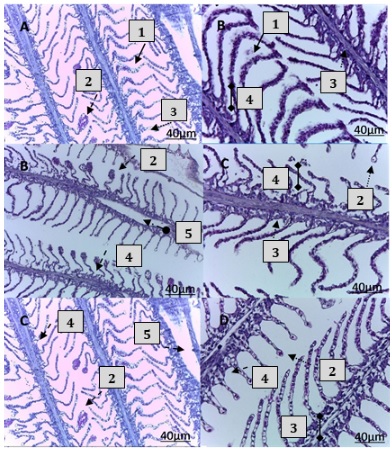Effect of total hardness of water on juvenile mullets (Mugil Liza) raised in fresh water
DOI:
https://doi.org/10.21708/avb.2023.17.1.11082Resumo
The aim of this study was to evaluate the effects of three fresh-water samples with different hardness values (25, 250, and 750 mg L-1 CaCO3) and a control (sea water with salinity 15% and hardness 2500 ± 130.9 mg L-1 CaCO3) on Mugil liza (mullet) juveniles by conducting a long-term test (for 50 days). Zootechnical performance [weight gain (WG), feed conversion rate, specific growth rate, and survival (%)], stress indicator parameters (glucose), and physiological parameters in gill tissues were analyzed to determine the fresh-water hardness range that can allow the optimal survival, growth, and feed conversion for the species. Fish with a mean initial weight of 22 ± 2.84 g were maintained under constant conditions of temperature, pH, alkalinity, and ammonia concentration, and they were fed four times per day with a commercial diet. When evaluating zootechnical performance, only survival (%) was not significantly different among treatments. For the other variables—weight gain, feed conversion, and specific growth rate—the best results were found in the treatment with 15% salinity (control). Blood glucose levels in animals maintained at 15% salinity (control) were significantly lower than those observed in the other treatments. Histological analyses corroborated the zootechnical data, potentially indicating stress in fish maintained at very low and very high water hardness. In conclusion, for cultivating juvenile mullets in fresh water, the most suitable hardness value was 250 mg L-1 CaCO3, because the best final weight of fish was achieved in that condition.
Downloads

Downloads
Publicado
Edição
Seção
Licença
Copyright (c) 2023 Acta Veterinaria Brasilica

Este trabalho está licenciado sob uma licença Creative Commons Attribution 4.0 International License.
Autores que publicam na Acta Veterinaria Brasilica concordam com os seguintes termos: a) Autores mantém os direitos autorais e concedem à revista o direito de primeira publicação, com o trabalho simultaneamente licenciado sob a Licença Creative Commons Attribution que permite o compartilhamento do trabalho com reconhecimento da autoria e publicação inicial nesta revista. b) Autores têm autorização para assumir contratos adicionais separadamente, para distribuição não-exclusiva da versão do trabalho publicada nesta revista (ex.: publicar em repositório institucional ou como capítulo de livro), com reconhecimento de autoria e publicação inicial nesta revista. c) Autores têm permissão e são estimulados a publicar e distribuir seu trabalho online (ex.: em repositórios institucionais ou na sua página pessoal) a qualquer ponto antes ou durante o processo editorial, já que isso pode gerar alterações produtivas, bem como aumentar o impacto e a citação do trabalho publicado (Veja O Efeito do Acesso Livre).


 Esta obra está licenciada com uma Licença
Esta obra está licenciada com uma Licença 